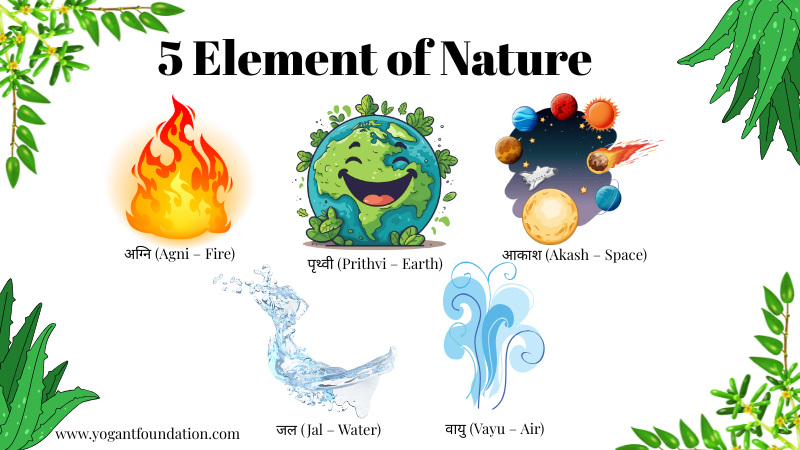5 Elements of Nature: Introduce yourself
Nature was considered to be the greatest teacher and healer by ancient cultures. Every aspect of our lives is connected to nature, whether it’s the huge sky above or the earth underfoot. In ancient Vedic thought, everything in the universe is made up of 5 elements of Nature. In Sanskrit, these elements are known as Pancha Mahabhutas and represent the foundations of the universe.
They are also found in our bodies. These five elements help us achieve spiritual growth and balance. The five elements of the Hindu pancha Mahabhutah are (पंच महाभूत) and (पञ्च महाभूताः).
We will be exploring:
- What is the nature of the 5 elements?
- The importance of these cells in the human body.
- The 5 basic elements have a meaning in Hindi & Sanskrit.
- The power of balancing the elements in your life.
What is nature’s 5 Elements?
The elements that make up nature:
- Earth– Structure, stability, and foundation.
- (Water) Fluidity, Emotions, and Purification.
- (Fire) Energy, Transformation, and Digestion.
- Air Movement, breathing, and the life force.
- Akasha Expansion and consciousness.
Each element is unique in its role to maintain harmony within and outside of us. Life is unstable without balance in these five areas.

1. Prithvi (Earth Elements) – The Foundation of Life
The element of earth represents strength, solidity, and grounding. The earth element is the one that gives form and structure to living beings and non-living ones. Mountains, soil, trees, muscles, and bones all represent.
Earth Elements in the Human Body
The earth element appears in the bones, teeth, and skin of our bodies. It provides us with stability, endurance, and growth.
Instability Signs
- Bones and muscles weaken
- Life is unstable.
- Insecurity and fear are all part of the anxiety continuum.
Earth Element Balancing
- The act of walking barefoot in the soil
- Root vegetables and natural grains
- Yoga poses such as Tadasana and Vrikshasana are grounding.

2. Jal (Water Element)- The Flow of Life
Water, which is vital for all life, represents purification, emotions, and adaptability. The Jal element can be found in rivers, oceans, and rainfall.
In the Human Body, Water is an element.
The water element plays a vital role in our bodies, which is composed of nearly 30% water. All fluids, such as blood, plasma, saliva, and other bodily fluids, are controlled by water.
Instability Signs
- Dehydration, skin dryness
- Emotional instability
- Digestive issues
The Water Element: Balancing it
- Purifying water with care
- Sheetali and Nadishodhana practice pranayama
- Consider spending time in the vicinity of rivers, lakes, or oceans

3. Agni (Fire element)- The energy of transformation
Fire is the source of transformation, power, and energy. It is believed that without fire, there wouldn’t be life. The solar energy that sustains us would not exist.
Inflammable Element of the Human Body
Humans have fire in the form of body temperature, digestion, metabolic rate, and vision. Fire transforms food into energy, and it fuels creative thinking.
Instability Signs
- Indigestion, acidity, or weak metabolism
- Anger is a feeling of frustration
- Low motivation and low energy
The Fire Element: Balancing it
- Practicing Surya Namaskar (Sun Salutation)
- Eat fresh, cooked, and warm food
- Trataka, or candle gazing meditation, and Sunbathing

4. Vayu (Air Element) – The Breath of Life
The air is what keeps the world moving. This air represents freedom, movement, and breath.
In the Human Body, Air is an Element
In the body, oxygen is also present as nerve impulses (life force), circulation, and prana. This element can be directly connected to breathing.
Instability Signs
- Fear of breathing, Breathing problems
- Overthinking and restlessness
- Poor circulation
Air Element Balancing
- Deep breathing (Anulom-Vilom, Bhramari).
- Practicing yoga postures like Pranayama Mudrasana
- Fresh air is good for you

5. Akasha – Space Element (Ether)
It is the subtlest element. It represents expansion, emptiness, and consciousness. This is the place where all elements are.
In the Human Body, Ether is an Element
Spaces in the body represent ether. These include the mouth, the nasal cavities, the chest cavities, the abdomen, and even our mind’s expansibility. It facilitates communication and spiritual connections.
Instability Signs
- Lost or feeling purposeless
- Clear thinking is difficult to achieve
- Detachment and Isolation
Ether Element Balancing
- Meditation and mindfulness
- Chanting mantras
- Enjoying silence and stillness
Pancha Mahabhuta: 5 Elements of Nature and Human Body
It is the micro-universe. We have five different elements in us, each in a slightly different ratio:
- Earth (Prithvi), Bones and muscles
- Water (Jal): Blood, fluids, saliva
- Fire (Agni): Digestion, energy, metabolism
- Air (Vayu): Breath, circulation, movement
- Akasha: Thoughts, awareness, space in organs
We experience vitality and health when these elements are in balance. Imbalance causes illness, suffering, and stress. Ayurveda, Yoga, and Meditation are all aimed at restoring harmony to these five elements.
5 Elements of Nature in Hindi (पाँच तत्व)
In Hindi, the 5 elements of nature are called:
- पृथ्वी (Prithvi – Earth)
- जल (Jal – Water)
- अग्नि (Agni – Fire)
- वायु (Vayu – Air)
- आकाश (Akash – Ether/Space)
Together, these elements form पंच महाभूत (Pancha Mahabhut). All creations on this planet, including human beings, are formed by these five elements.
5 Elements of Nature in Sanskrit (पञ्च महाभूताः)
Sanskrit refers to the five elements as:
- पृथ्वी (Prithvi) – Earth
- आपः (Apas/Jal) – Water
- अग्नि (Agni/Tejas) – Fire
- वायु (Vayu) – Air
- आकाश (Akasha) – Ether/Space
It is a concept that is deeply embedded in Ayurveda, Yoga, and Indian Philosophy. In these traditions, the harmony of all elements is essential to a happy life.
Spiritual Importance of the 5 Elements
- The Earth: A symbol of survival.
- Water symbolizes emotion and purification.
- Fire is a symbol of transformation and energy.
- Air is a symbol of intelligence and creativeness.
- Ether signifies connection to the spiritual and freedom.
These elements can help you achieve a harmonious mind, body, and soul.
What are the Five Elements?
- Perform Yoga Asanas– Each element is associated with specific yoga positions to promote balance.
- Ayurvedic Foods– Consume foods that nourish and balance the dominant element in your body (Dosha).
- Meditative & Mantras– Chant Om (for ether), focus on breathing for air, practise trataka for the fire, Flow Mediation for the water, and grounding for the earth.
- Enjoy Nature: Spend time in nature to experience the balance of nature.
- Living Mindfully — Balance is achieved by being aware of our thoughts, emotions, and actions.
You can also read our conclusion.
The 5 elements of nature aren’t just abstract concepts. Earth, Water and Fire, Air, and Ether represent the essence of life. There are five elements in all of us: body, mind, soul, and spirit. In Hindi, these words are पंच महाभूत and in Sanskrit पञ्च महाभूता.
It is possible to attain physical health, mental happiness, and spiritual progress by understanding and balancing the five elements. In harmony with nature, we are able to reconnect ourselves with our self-worth and with the world.



